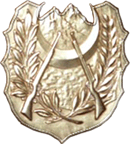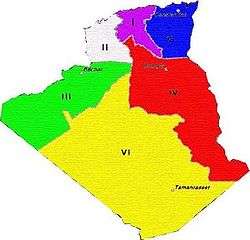Algerian People's National Army
The Land Forces of the People's National Army (Arabic: القوات البرية الجزائرية,[2] French: Forces Terrestres Algériennes[3]) are the land forces of the Algerian People's National Armed Forces. The Armée Nationale Populaire's equipment is supplied by Russia, and various other countries.
| Algerian Land Forces | |
|---|---|
| Arabic: القوات البرية الجزائرية French: Forces Terrestres Algériennes | |
 ANP emblem | |
| Founded | 1962 (Formerly the Armée de Libération Nationale) |
| Country | |
| Branch | Army |
| Role | Land warfare |
| Size | 110,000[1] |
| Part of | Algerian People's National Armed Forces |
| Headquarters | Algiers |
| Website | http://www.mdn.dz/ |
| Commanders | |
| Chief of Staff of the People's National Army | Saïd Chengriha |
| Commander, Land Forces | Major General Ammar Atamnia |
The Army includes two armoured and two mechanised divisions,[4] one of which is the 8th Armoured Division based at Ras El Ma, 90 kilometres from Sidi Bel Abbes,[5] in the 2nd Military Region. The division was formed from the 8th Armoured Brigade after 1988 (the 8th Armoured Brigade seems to have been formed in 1976). The other armoured division was named by IISS 2017 as the 1st. Another is the 40th Mechanised Infantry Division apparently based in the 3rd Military Region. The mission of the 40th Division is usually the protection of the Algerian-Moroccan frontier.[6] The IISS Military Balance 2013 named the other mechanised division as the 12th. There may be a single independent armoured brigade, the 41st Armoured Brigade in the In Amenas area, and the IISS said in 2020 that the 38th Motorised Brigade was located at Tindouf.[7]
There have also been French reports of an airborne division formed in the early 1990s.[8] This formation, the 17th Parachute Division, with five airborne regiments, seemingly similar to the French reporting, was listed in the IISS Military Balance for 2001-02 and 2006, but not listed in the 2007 edition. It was listed with four regiments and a special forces regiment in the 2017 edition (p.368).
Creation and development
After the end of the liberation war in June 1962, the first objective was to establish a logistics organization to meet the needs of the army - a structure to feed, clothe, care for and train. The directorates of Stewardship, Hardware, Engineering and Health, Transport and Supply were the first to emerge. These directorates, which came quickly join those of the staff of the Air Force, Navy and Education, at the Ministry, would form the backbone of the National People's Army. The bases of the general structure of the army were consolidated with the creation of the main directions, the establishment of an effective organization, the opening of schools and instruction centers and sending abroad trainees for different weapons and services.
Efforts to develop and modernize the ANP continued throughout the 1970s and 80s, at the organizational level with the formation of battalions and brigades. During the eighties, the army experienced considerable growth. Thus, in 1986, a restructuring began, based primarily on the implementation of large units combining firepower and gradual movement, i.e. combat divisions, equipped with sophisticated weapons systems and other equipment necessary for the use and maintenance of these systems. This modernization was not just about the hardware, but included all organizational areas and combat. Thus was created the General Inspection of the PNA.
The Algerian military provided young men, from disadvantaged backgrounds, the opportunity to move up in society. This opportunity played a strong role in southeast Algeria, the Aures and Nemencha mountains, where the Shawiyya Berbers lived.[9]
Military regions

Algeria is divided into seven numbered military regions, each with headquarters located in a principal city or town. This system of territorial organization, adopted shortly after independence, grew out of the wartime wilaya structure and the postwar necessity of subduing antigovernment insurgencies that were based in the various regions. Regional commanders control and administer bases, logistics, and housing, as well as conscript training. Commanders of army divisions and brigades, air force installations, and naval forces report directly to the Ministry of National Defense and service chiefs of staff on operational matters.[10]
During the 1980s, most of the army's combat units were concentrated in the 2nd Military Region (Oran) and to a lesser extent in the 3rd Military Region (Béchar).[11] Chadli Bendjedid became head of the 2nd Military Region in 1964. Adjacent to Morocco, the 3rd Military Region straddles the main access routes from that country. It is also near the troubled Western Sahara, embracing territory previously claimed by Morocco. Much of the internal disorder and violence associated with economic distress and the Islamist movement has occurred in the 1st Military Region (Blida), which includes the capital of Algiers, and the 5th Military Region (Constantine). Army units have been strengthened in and near the cities where attacks against the government and security forces have occurred. Although regional commanders were originally all colonels, the commanders of the 1st Military Region (Mohamed Djenouhat) and the 5th Military Region (Abdelhamid Djouadi) were both promoted to major general in 1992. The two southeastern jurisdictions — the 4th Military Region (Ouargla) and 6th Military Region (Tamanrasset) — were sparsely populated tracts of desert where a limited number of combat troops carried out patrols and manned small outposts. The Ouargla region assumed a measure of strategic importance after relations with Libya soured, but the military's main activities there and in the 6th Military Region are the construction and planting projects undertaken by conscript forces. The 6th Military Region was created in 1975 to cover the south.[12]
On February 24, 2000, there was a large change of guards in the military regions, where four commanders of the six were changed. From this reshuffling, the previous French army officers took power of the Algerian army and the shift in power correlated with the change of a national service and alteration of the ANP to a professional army.
President Bouteflika, as Minister of Defence, nominated new commanders for military regions in August 2004. (BICC) In 2010 there were a further series of changes. Président Bouteflika changed the commanders of three military regions, according to the presidential décrees published Wednesday 25 August in the Algerian Journal officiel. Général Mohand-Ameziane Si-Mohand was nominated to head the 3rd Military Region, le général Hassen Alaimia prend les commandes de la 4th Military Region et la 5e est désormais dirigée par le général Saïd Ziad.[13] These nominations took effect from 1 August, selon les mêmes décrets. President Bouteflika also named new deputy commanders in these military regions.
In 2013, a 7th Military Region was formed at Illizi in the south.[14]
Equipment
The inventory of the Algerian People's National Army mainly includes equipment from the Soviet Union and its successor Russia, and to a lesser degree from China and Germany.
References
- IISS 2020, p. 340
- https://www.mdn.dz/site_cft/index_ar.php?id=4
- https://www.mdn.dz/site_cft/index_fr.php?id=4
- IISS Military Balance 2020, p.340, down from two armoured and three mechanised divisions reported by IISS MB 2007
- Le Soir Algerie, Voyage au cœur de la 8e Division blindée Archived 2015-10-03 at the Wayback Machine, 1997; also IISS Military Balance 2020, p.337
- http://www.algeria-watch.org/pdf/pdf_en/forces_repression.pdf. http://www.algeria-watch.org/fr/mrv/mrvmili/tigha_patriotes.htm; IISS Military Balance 2020, p.337 named the division's base as Bechar.
- IISS Military Balance 2020, p.337
- Centre Francais de recherche sur la reseignement, Bulletin de documentation 5 Archived 2015-01-11 at the Wayback Machine, accessed January 2014.
- Roberts, Hugh (2003). The Battlefield Algeria, 1988-2002: Studies in a Broken Polity. London: Verso. pp. 273–274.
- "Library of Congress Country Study, 1993, 258-260" (PDF). Retrieved Mar 31, 2019.
- "New Commander of Third Military District". December 2, 1974 – via WikiLeaks PlusD.
- "L'Algérie est-elle en situation de guerre ? | Analyse" [Is Algeria in a state of war?] (in French). Lematindz.net. Retrieved 2018-01-27.
- Vaste mouvement dans les structures des Régions Militaires Archived 2015-01-06 at the Wayback Machine, 26 August 2010
- "L'Expression - Le Quotidien - L'Algérie prévoit une 7e Région militaire" [Algeria plans a 7th Military Region] (in French). Lexpressiondz.com. Archived from the original on 2018-01-29. Retrieved 2018-01-27.
Bibliography
- International Institute for Strategic Studies (14 February 2020). The Military Balance 2020. London: Routledge. ISBN 978-0-367-46639-8.
